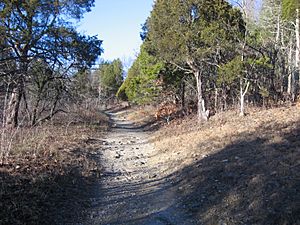Blue Licks Battlefield State Resort Park facts for kids
Quick facts for kids Blue Licks Battlefield State Resort Park |
|
|---|---|

An ancient Bison trail through one of the Blue Licks cedar glades
|
|
| Lua error in Module:Location_map at line 420: attempt to index field 'wikibase' (a nil value). | |
| Type | Kentucky State Park |
| Area | 148 acres (60 ha) |
| Elevation | 640 feet (200 m) |
| Created | 1927 |
| Operated by | Kentucky Department of Parks and the Kentucky State Nature Preserves Commission |
| Open | Year-round |
Blue Licks Battlefield State Resort Park is a special place in Kentucky where history and nature meet! Located near Mount Olivet, Kentucky in Robertson and Nicholas counties, this park covers about 148 acres. It's famous for a monument that remembers the Battle of Blue Licks, which happened on August 19, 1782. Many people consider this battle to be the very last fight of the American Revolutionary War.
Contents
A Glimpse into the Past
Why Animals Loved Blue Licks
Long ago, Blue Licks was a popular spot for animals. They came to lick the salty deposits that flowed from the natural springs. Imagine huge herds of bison, elk, and even woolly mammoths gathering here! They wore down the earth with their constant visits, creating wide paths that all led to the salty springs. It was like a giant animal magnet!
The Battle of Blue Licks
In 1782, during the American Revolutionary War, a group of British soldiers and Native American warriors, led by Captain William Caldwell, attacked a small settlement called Bryan's Station. The settlers fought bravely, and Caldwell's group eventually retreated.
A group of pioneers, including the famous Daniel Boone, wanted to wait for more soldiers before chasing the enemy. However, Major Hugh McGary decided to pursue them right away. This led to a fierce battle at Blue Licks. Sadly, many pioneers were killed or captured, including Daniel Boone's son, Israel. Later, more soldiers arrived to bury the fallen heroes.
From Battlefield to Health Resort
Years after the battle, in the mid-1800s, Blue Licks became a popular health resort. People believed the mineral-rich saltwater from the springs could help cure many illnesses. They even used the salt for "salt making" since the 1770s. However, by 1896, the springs dried up. When people tried to find new springs, they discovered amazing historical items and fossils!
Protecting a Historic Site
The Blue Licks battlefield was once listed on the National Register of Historic Places. This list helps protect important historical sites. Later, it was removed because experts thought the site had changed too much over time. But now, a team from Morehead State University is using modern tools to search for artifacts. If they find enough, the battlefield might be added back to the Register!
Fun Things to Do at the Park
Outdoor Adventures
Blue Licks Battlefield State Resort Park is located right along the Licking River. You can enjoy canoeing and fishing in the river. There's also the Licking River Trail, a one-mile (1.6 km) path perfect for a hike along the riverbank. If you want to stay longer, the park has a 32-room lodge and a campground with 51 sites.
Exploring the State Nature Preserve
The park also has a special 15-acre nature preserve. This area protects a unique cedar glade. A cedar glade is an open, rocky area where certain plants grow. Long ago, huge animals like bison and mammoths kept this area clear. Today, park rangers use special methods like controlled burns and removing Eastern redcedar trees to keep the glade open. This helps protect rare plants like the federally endangered Short's goldenrod and the state threatened Great Plains Ladies'-tresses.
Discoveries at the Pioneer Museum
The Pioneer Museum is a must-see! It's full of amazing artifacts that tell the story of the area. You can see a mastodon tooth found during an excavation, and items from the American Civil War. The museum teaches you about prehistoric animals, fossils, local Native American tribes, and the brave pioneers of the 18th century. There's even a cool diorama that shows what the Battle of Blue Licks might have looked like! The museum was updated in 2007 and is a great place to learn.
Annual Events and Celebrations
Every year in mid-August, the park hosts the Battle of Blue Licks celebration. You can watch a re-enactment of the historic battle! There was also the Short's Goldenrod Festival, which celebrated one of Kentucky's rarest plants. It was held annually in late September until 2008.


